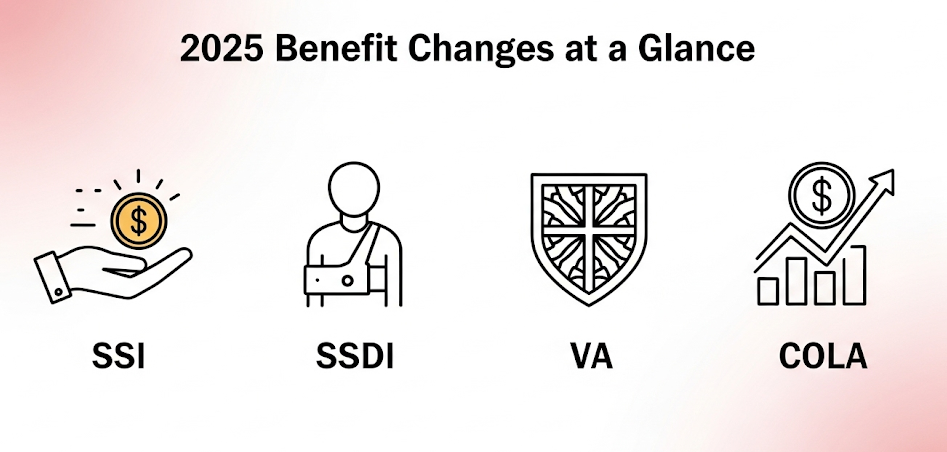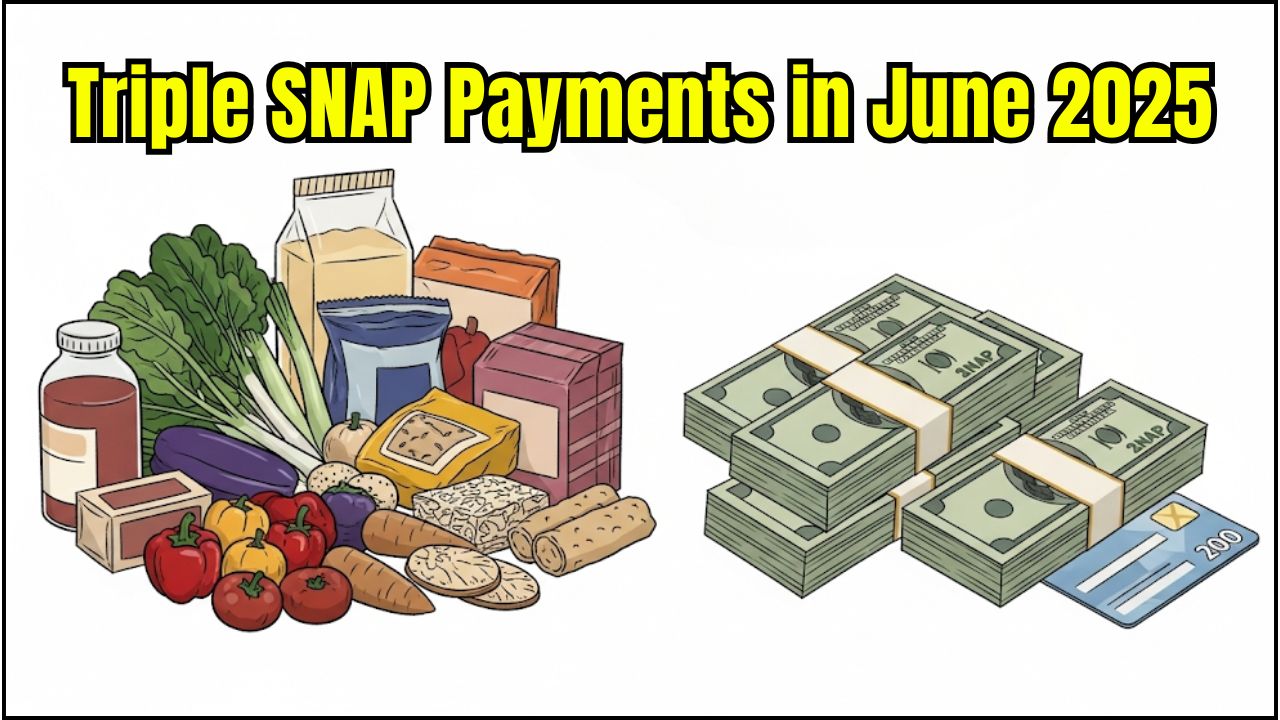Social Security, SSI, SSDI & VA benefits 2025 just got real—we’re talkin’ confirmed payment dates, COLA increases, and new rules that could shake things up for millions of Americans. Whether you’re a retiree in the Dakotas, a young vet in Arizona, or a parent managing benefits for your child, this guide has the who, what, when, and how covered.
With so many folks depending on these lifelines to cover rent, food, meds, and everything in between, staying up-to-date isn’t just smart—it’s essential. So let’s break it all down in plain English with expert insights, clear examples, straight talk, and bonus strategies that help you get the most bang for your buck.

What’s the Difference Between SSI and SSDI?
It’s easy to mix them up! Social Security Disability Insurance (SSDI) is for folks who have worked and paid Social Security taxes long enough to earn coverage. On the other hand, Supplemental Security Income (SSI) is a needs-based program that provides payments to adults and children with disabilities or who are age 65 or older and have very limited income and resources, regardless of their work history.
Looking back, the annual Cost-of-Living Adjustment (COLA) really shows how much economic conditions can change. For example, the COLA increase for 2023 was a significant 8.7%, reflecting a period of high inflation. For 2024, it was a more moderate 3.2%. Projections for the 2025 COLA are currently hovering in a similar range, signaling that while inflation has cooled, it still impacts the purchasing power of every benefit dollar you receive.
Social Security, SSI, SSDI, and VA Benefits 2025
| Benefit Type | Amount & Payment Schedule | Need-to-Know |
|---|---|---|
| SSI | $967/month (individual), $1,450 (couple); Paid 1st of month or prior business day | COLA increased by 2.5% in 2025; watch for early payments due to holidays |
| SSDI | Avg. $1,483/month; Max $3,627; Paid on Wednesdays by birthdate | New overpayment rule: up to 50% can be withheld on new notices |
| Social Security (Retirement) | Avg. $1,976/month; Max $5,108 (age 70); Wednesday schedule | Earnings limit applies before FRA; COLA boost of 2.5% |
| VA Disability | Approx. $1,102/month (50% rating); Paid on 1st business day | Tax-free; rates vary by dependents and rating |
| New Law | GPO/WEP repealed Jan 5, 2025 | Public workers now receive full SS benefits |
| Tax Break | Through 2028, federal tax reduced on some SS benefits | Big win for mid-income retirees |
| Earnings Limit (Under FRA) | $23,400/year | Excess earnings may reduce monthly benefit |
With new rules, boosted payouts, and important timing changes, 2025 is shaping up to be a big year for Social Security, SSI, SSDI, and VA recipients. By staying on top of the payment calendar, COLA updates, and policy changes, you’ll avoid surprises and keep more money in your pocket.
Whether you’re drawing benefits yourself or helping someone else navigate the system, now is the time to double-check your setup, go paperless, and understand your rights.
What’s New in 2025?
COLA Adjustments
- Social Security, SSDI, and SSI recipients saw a 2.5% COLA (Cost-of-Living Adjustment) beginning January 2025.
- VA Disability Compensation follows suit with a similar increase.

Overpayment Rules Tightened
If you receive a new overpayment notice after April 25, 2025, the SSA can now withhold up to 50% of your monthly benefits—a big jump from the 10% cap. Appeals and waivers are available.
Social Security Fairness Act
Signed into law in January 2025, this repeals GPO and WEP, which penalized public servants like teachers and firefighters. Now, they receive full Social Security benefits alongside their pensions.
Tax Relief for Retirees
Starting in 2025, a temporary federal tax break on Social Security benefits kicks in, reducing taxable portions for moderate-income seniors. This lasts through 2028 and could mean hundreds back in your pocket every year.
Payment Calendar: SSI, SSDI, Social Security, VA
SSI (Supplemental Security Income)
Paid on the 1st of each month, or earlier if the 1st is a weekend or federal holiday.
Examples:
- May 2025: Paid May 1
- June 2025: Paid May 30 (because June 1 is a Sunday)
- September 2025: Paid August 30 (Labor Day on Sept 1)
SSDI & Social Security (Retirement)
Paid on Wednesdays based on your birthdate:
- Birthdays 1st–10th: 2nd Wednesday
- 11th–20th: 3rd Wednesday
- 21st–31st: 4th Wednesday
July 2025 Schedule:
- July 9, 16, 23
VA Disability
Paid on the first business day of each month. If the 1st is a weekend or holiday, payment arrives the previous business day.
How Much Will You Get?
SSI
- Individual: $967/month
- Couple: $1,450/month
SSDI
- Average: $1,483/month
- Maximum (high earners): $3,627/month
Social Security (Retirement)
- Average: $1,976/month
- Maximum (at age 70): $5,108/month
VA Disability (Example: 50% rating)
- Base Rate: $1,102/month (tax-free)
- Increases with dependents and special status
Benefit Payment Schedules: 2024 vs. 2025
While the core payment system remains the same, the exact dates can shift year to year, especially when payment dates fall on a weekend or holiday. Here’s a quick comparison:
| Benefit Program | Typical 2024 Payment Schedule | Expected 2025 Payment Schedule |
| SSI | 1st of the month | 1st of the month (unless it’s a weekend/holiday, then the prior business day) |
| VA Benefits | 1st of the month | 1st of the month (unless it’s a weekend/holiday, then the prior business day) |
| Social Security | Based on your birth date (2nd, 3rd, or 4th Wednesday of the month) | Based on your birth date (2nd, 3rd, or 4th Wednesday of the month) |
| SSDI | Follows the Social Security schedule | Follows the Social Security schedule |

Smart Tips to Maximize Benefits
1. Sign Up for Direct Deposit
Checks can get lost, stolen, or delayed. Direct deposit is faster and safer. Sign up at GoDirect.gov or through SSA/VA.
2. Create a “My Social Security” Account
Track benefits, verify payment dates, access tax forms, and receive alerts. Visit ssa.gov/myaccount.
3. Watch Out for Overpayment Notices
If you receive one, respond quickly. You can:
- Appeal
- Request a waiver
- Set up a payment plan
4. Know Your Earnings Limit
If you’re under Full Retirement Age (FRA):
- Earn up to $23,400 in 2025 before deductions kick in.
- Earn over $62,160 in the year you reach FRA before partial deductions apply.
5. Explore State-Level Benefits
Some states offer additional programs for SSI or SSDI recipients—like utility help, SNAP auto-enrollment, or Medicare premium rebates. Contact your local Department of Human Services.
6. Use SSA’s Retirement Estimator Tool
It shows how retiring at 62, FRA, or 70 affects your monthly check. Use it to pick the best time to file.
7. Know Your Tax Rights
For 2025–2028, many middle-income retirees will pay less federal tax on their Social Security benefits due to the temporary relief law. This could mean fewer withholdings and more take-home money.
FAQs
Q: When will I get my first COLA-boosted check?
A: January 2025 for Social Security, SSDI, and VA; SSI recipients received theirs on December 29, 2024 (early due to the holiday).
Q: Why did I get two checks in one month?
A: It’s just the calendar—when the 1st falls on a weekend, SSA pays the check early.
Q: Is VA Disability taxable?
A: Nope! It’s tax-free at both state and federal levels.
Q: Can I still work and receive Social Security?
A: Yes, but earnings limits apply until you reach FRA. Watch your thresholds!
Q: Where do I appeal an overpayment?
A: Start at ssa.gov or call 1-800-772-1213.
Q: Do my Social Security benefits increase if I delay retirement?
A: Yes! Waiting past your FRA can boost your benefits by up to 8% per year until age 70.





